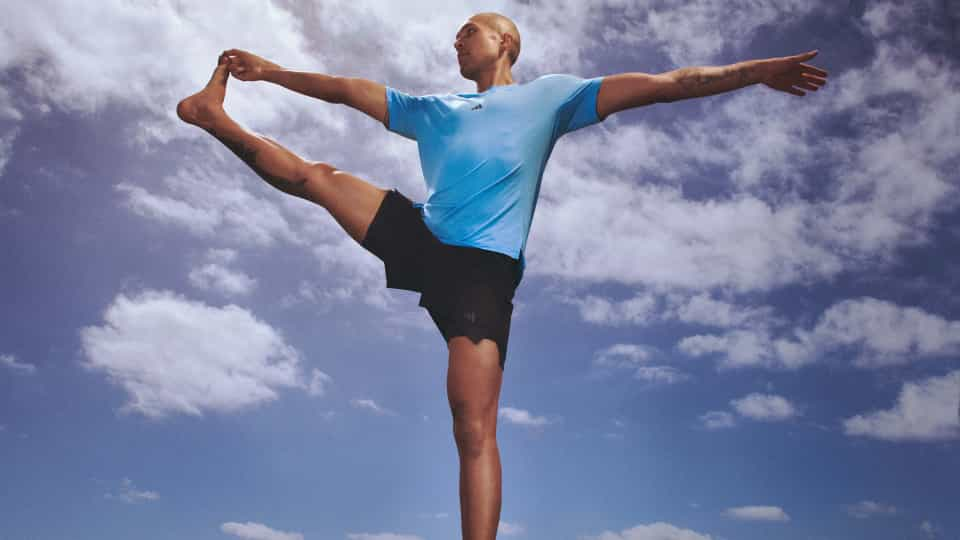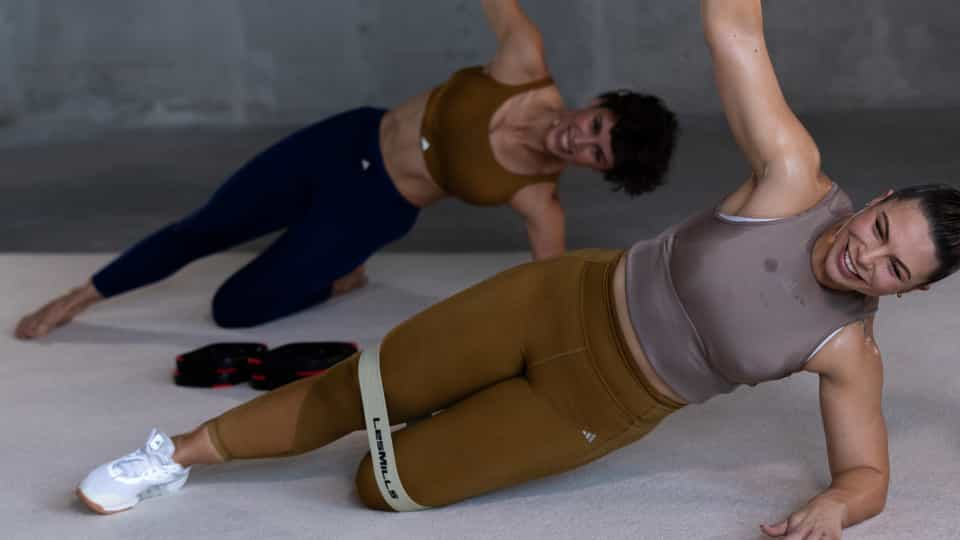Lifting weights to lighten mental load
If Ben Main feels like nothing is going right for him and he can’t concentrate on his work, he knows it’s time to focus on his mindset. “I’m kind of superstitious, so if I know I can change things then I’m gonna make it happen!” He says that with a good workout, he can build the momentum he needs to shift his mindset from one end of the spectrum to the other.
In these situations, strength training is his go-to – specifically an upper-body German volume training session. "10 sets of 10 reps. I don't have time to think about anything else except nailing 100 reps on the bench press and then 100 lat pulldowns. Completing 130 reps of one move (30 warm-up and 100 working a decent weight) gives me that pumped feeling. Every rep is a fight and it takes mental and physical strength to achieve. The feeling that I get from making it through gives me the confidence to attack the day.”
SCIENCE SAYS:
Research shows weightlifting is a surefire way to ease feelings of stress and anxiety. The powerful perks of resistance training are on par with antidepressant medications or psychotherapy – and studies show you can still feel the effects whether you lift heavy or go light. This suggests it’s not about the strength you build, but the feeling of accomplishment and confidence that comes from lifting weights. Looking for a smart place to start? Try squats, lunges and planks, as these exercises all strengthen the core and promote improved posture – and better posture is linked to a better mood.

Finding balance
Dannielle Lally has spent many years dealing with mental health issues, working hard to become more self-aware and in tune with her emotions. "I recognize that I am highly emotional (to add to the mix, I’m also a Pisces). Nowadays, I mostly cry happy tears, but when I start crying over the smallest things (e.g. “I dropped my coffee” cue big tears) I know my mental health is starting to slide. Another tell-tale sign is that I start to recluse away and ghost the world, a complete 360 as I love being around my family, friends and community.
My go-to workout for a mental health pick-me-up is BODYBALANCE. It's restorative, inclusive, and connects to your wairua (spirit). I love how you can slowly ease yourself into it – you don’t have to be going ‘hundy guns’ (aka hard out) like when you do other workouts that demand big energy. The coaching encourages you to tune into your present state and focus on your breath.
If I need the extra boost, sometimes I'll turn my lounge into a cute yoga studio by lighting candles and getting my favorite incense on. I'll pop on my favorite 'buttery' adidas yoga tights and bra, dim the lights, and even grab a lemon water. It's a full mood-booster space. Positive vibes only.
I know when it’s working because halfway through the class I feel this ‘wave of positive energy’ #IYKYK. At the end, I feel validated with a sense of confidence.”
SCIENCE SAYS:
BODYBALANCE™ uses a combination of yoga, Pilates and Tai Chi to build strength, improve flexibility and create a sense of calm. Research shows it can quickly reduce feelings of anxiety, tension and sadness, while helping you sleep better and feel more confident and motivated. The reason it has these effects is because it helps improve your body’s heart rate variability (HRV). This is the measure of variation between heartbeats which indicates a healthy cardiovascular system. Studies link having low HRV to anxiety and increased risk of cardiovascular disease. When you take action to improve HRV, you are better able to shift from a state of stress to relaxation.
Discover the best time to do BODYBALANCE for optimal results.

Flow and focus to calm anxiety
Otto Prodan has a lot of anxiety. “It’s something that I’ve been dealing with since I was a kid. I know when it’s happening because my mind keeps circling back to the same subject, I worry, I create scenarios in my head and my body gets all tight.
I’ve learned to keep things in check by learning to slow down and breathe. This is where yoga comes in. It allows me to reduce stress physically, which helps me feel good internally/mentally.
When I’m practising yoga, I'm fully present with my body and my mind goes quiet. I feel like nothing else matters at that moment, so it really feels like self-care.
I know it's working because after class I usually come up with new ideas, I feel inspired and relaxed. I also feel like my heart rate and my breath are controlled, so it's easier for me to make decisions and think more clearly.”
SCIENCE SAYS:
Yoga is highly regarded as a powerful antidote for stress, anxiety and depression. Scientists have found it helps regulate two important stress response systems – our autonomic nervous system and the hypothalamic-pituitary axis. When you flow through yoga moves, it can spark changes in your brain's hippocampus and the prefrontal cortex, which help manage decision-making, stress and emotional regulation. These changes in brain structure and function are key to helping our bodies respond, rather than react, to stress. Many experts consider yoga a safe and effective alternative to medication and some researchers found that the effects of yoga on depression were comparable to that of pharmacological treatment, group therapy, social support groups, and massage.
High-intensity for happiness
When Summer Bradley is feeling mentally off balance she starts to feel overwhelmed and busy, struggling to prioritize what she needs to do. She says taking time out for a workout is the perfect state shift. “I usually go for one of two extremes… LES MILLS GRITÔ Cardio or a stretch session.
I love the rush of a high-energy GRIT Cardio class. It’s intense and it tests my limits. I get instant satisfaction from doing something hard. When I push past my limits at the gym, it translates into an ‘I can do this’ belief throughout the rest of my day. On the flip side, there are times when I need to calm my mind. That's when I choose to stretch. An intuitive flow session on my bedroom floor has become my go-to practice when I'm stressed before bedtime. Stretching usually brings up emotions for me. Releasing my physical body has the same effect on my mind.
SCIENCE SAYS
Not only is High-Intensity Interval Training (HIIT) one of the most powerful ways to transform your health and fitness, studies show it can have a positive effect on mental wellbeing, symptoms of depression, anxiety and psychological stress. High-intensity cardio is generally more effective than low-intensity and is strongly associated with helping reduce depression and having a moderate but reliable effect on symptoms associated with anxiety disorders.
Low-impact for a big boost
Kaylah-Blayr Fitzsimons-Nu’u knows when she needs to take care of her mental wellbeing. “I start to feel more tired, less motivated and more emotional than usual. I don’t feel like being around people and I want to stay at home – usually wearing very baggy comfortable clothes!”
When these tell-tale signs hit, she finds a low-impact workout delivers a high return on the mental health stakes.
“By choosing a workout like BODYBALANCE I can focus on breathwork and bring calmness to my mind – and it leaves me with less tension and anxiety in my body.” If she has a little more energy, she turns to LES MILLS SHAPES™ to bring the burn and soothe her mood. “It’s low impact, but I get a great whole-body training sesh and it doesn't leave me feeling exhausted in the head.”
SCIENCE SAYS:
Workouts like LES MILLS SHAPES are packed with Pilates-inspired moves shown to reduce stress while boosting mood, energy and motivation. The benefits kick in as you focus on controlled movement and breathwork, which results in your nervous system lowering cortisol levels, and this helps lower stress over time. As with any exercise, the increased oxygen flow and blood circulation stimulate feel-good endorphins and give you a boost of energy.
What's the winning workout routine for mental wellness?

Experts reviewed 1,444 studies exploring exercise and mental health. Here's where you can find out what approach came out on top.
GET THE ANSWER









